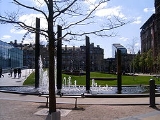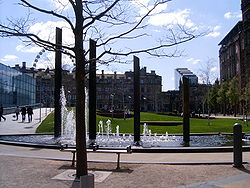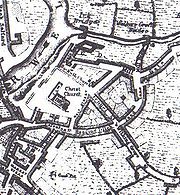
Cathedral Gardens
Encyclopedia

Manchester City Centre
Manchester city centre is the central business district of Manchester, England. It lies within the Manchester Inner Ring Road, next to the River Irwell...
, in North West England
North West England
North West England, informally known as The North West, is one of the nine official regions of England.North West England had a 2006 estimated population of 6,853,201 the third most populated region after London and the South East...
. It is bounded by Victoria railway station
Manchester Victoria station
Manchester Victoria station in Manchester, England is the city's second largest mainline railway station. It is also a Metrolink station, one of eight within the City Zone...
to the north, Chetham's School of Music
Chetham's School of Music
Chetham's School of Music , familiarly known as "Chets", is a specialist independent co-educational music school, situated in Manchester city centre, in North West England. It was established in 1969, incorporating Chetham's Hospital School, founded as a charity school by Humphrey Chetham in 1653...
to the west, the perimeter of Manchester Cathedral
Manchester Cathedral
Manchester Cathedral is a medieval church on Victoria Street in central Manchester and is the seat of the Bishop of Manchester. The cathedral's official name is The Cathedral and Collegiate Church of St Mary, St Denys and St George in Manchester...
and The Triangle
Corn Exchange, Manchester
The Triangle is a grade II listed building in Manchester, England. The building was originally used as a corn exchange and was previously named the Corn & Produce Exchange. Following the IRA bomb in 1996 it was renovated and is now a modern shopping mall....
on Fennel Street to the south and Urbis
Urbis
Urbis is an exhibition centre located in Manchester, England. From 2002 to 2010, the centre hosted changing exhibits on popular culture topics including urban living, art, music, fashion, photography and videogames alongside talks, gigs and special events....
to the east.
Earliest history

Industrial Revolution
The Industrial Revolution was a period from the 18th to the 19th century where major changes in agriculture, manufacturing, mining, transportation, and technology had a profound effect on the social, economic and cultural conditions of the times...
, Manchester was little more than a small market town, and the town centre centred on the cathedral. The area where Cathedral Gardens now stands was enclosed by small cottages. After the industrial revolution Manchester quickly built up, and the centre of Manchester shifted further south. Cathedral Gardens is overlooked by Chetham's Library
Chetham's Library
Chetham's Library in Manchester, England is the oldest free public reference library in the United Kingdom. Chetham's Hospital, which contains both the library and Chetham's School of Music, was established in 1653 under the will of Humphrey Chetham , for the education of "the sons of honest,...
, part of the Chetham's School of Music
Chetham's School of Music
Chetham's School of Music , familiarly known as "Chets", is a specialist independent co-educational music school, situated in Manchester city centre, in North West England. It was established in 1969, incorporating Chetham's Hospital School, founded as a charity school by Humphrey Chetham in 1653...
, where Karl Marx
Karl Marx
Karl Heinrich Marx was a German philosopher, economist, sociologist, historian, journalist, and revolutionary socialist. His ideas played a significant role in the development of social science and the socialist political movement...
and Friedrich Engels
Friedrich Engels
Friedrich Engels was a German industrialist, social scientist, author, political theorist, philosopher, and father of Marxist theory, alongside Karl Marx. In 1845 he published The Condition of the Working Class in England, based on personal observations and research...
wrote.
After the Victoria railway station
Manchester Victoria station
Manchester Victoria station in Manchester, England is the city's second largest mainline railway station. It is also a Metrolink station, one of eight within the City Zone...
was built in the 1860s, the site housed travellers, hotels and shops, and this was the situation until urban planning of the 1980s, demolished the now derelict hotel which faced south along Fennel Street looking directly at the Corn Exchange, now The Triangle shopping precinct.
The site remained empty, used as a car park until the regeneration of Manchester city centre.
Manchester IRA bombing
The Provisional IRA carried out various phases of bombings of mainland British Cities, for thirty years. Manchester was variously targeted in the 1990s, which culminated in the Manchester IRA bombing1996 Manchester bombing
The 1996 Manchester bombing was an attack carried out by the Provisional Irish Republican Army on 15 June 1996 in Manchester, England. The bomb, placed in a van on Corporation Street in city centre, targeted the city's infrastructure and economy and caused widespread damage, estimated by...
on June 15th, 1996.
The bombing, which happened on a warm Saturday morning, whilst Manchester was hosting a European football event (UEFA 1996
1996 UEFA European Football Championship
The 1996 UEFA European Football Championship was hosted by England, who won the right to host the tournament ahead of bids from Austria, Portugal and the Netherlands. It was the tenth European Football Championship, which is held every four years and endorsed by UEFA. It was the first to use the...
) was the largest bombing on British soil. It created devastation up to in a radius of half a mile of the impact site. The Marks and Spencer store was damaged beyond useful repair. Nobody was killed.
Regeneration
After the bombing, the British government, awarded Manchester City CouncilManchester City Council
Manchester City Council is the local government authority for Manchester, a city and metropolitan borough in Greater Manchester, England. It is composed of 96 councillors, three for each of the 32 electoral wards of Manchester. Currently the council is controlled by the Labour Party and is led by...
an award of several million pounds, to redevelop the most damaged sites in the city. After an International competition, several architects were charged with creating an accessible open space linking St Anne’s Square
St Ann's Church, Manchester
St Ann's Church, Manchester, was consecrated in 1712. Although named after St Anne, it also pays tribute to the patron of the church, Ann, Lady Bland. St Ann's Church is a Grade I listed building.-Architecture and setting:...
to the Cathedral. After the completion of the new Marks and Spencer flagship store (then the largest in the world) and the Urbis
Urbis
Urbis is an exhibition centre located in Manchester, England. From 2002 to 2010, the centre hosted changing exhibits on popular culture topics including urban living, art, music, fashion, photography and videogames alongside talks, gigs and special events....
gallery, Cathedral Gardens was opened up to the public.

